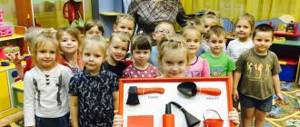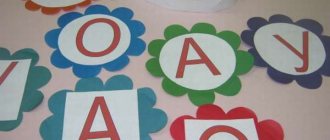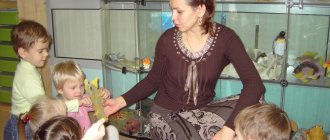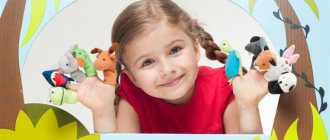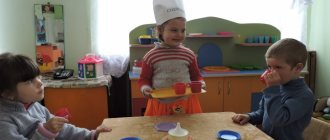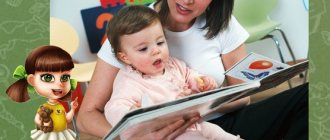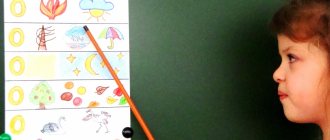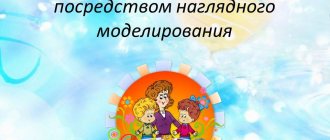Text of the book “Development of gaming activity. System of work in the middle group of kindergarten"
Kindergarten games
On the topic of games in kindergarten, you can offer a block of game-situations “Classes in kindergarten”, which includes various types of preliminary and main work.
Block 1. Game-situation “Classes in kindergarten”
Preliminary work.
During the children's stay in kindergarten, the teacher shows them the work of employees (teachers, cooks, laundresses, manager, nanny, methodologist, cleaners, janitors, wardrobe maid, music director, etc.) during special moments of free communication between children, on special excursions, targeted walks and observations. In subsequent lessons with children, the teacher must use these impressions and knowledge gained. So, after an excursion to the kitchen, the teacher, using real products, can show how pies are prepared. Gradually, the children begin to understand more clearly the work of the staff, the daily routine and the educational process in kindergarten: how the teacher greets children in the morning when they come from home with their parents, how classes are conducted, how the tables are set for meals, what you can do on a walk, how holidays are held. and entertainment, how children play, draw and sculpt in their free evening hours and meet their parents, how teachers talk with parents about raising children, and much more - all this often becomes the content of children’s amateur role-playing games.
The teacher, watching children play in kindergarten, will be able to make sure how children perceive the environment of the kindergarten, what interests them and what they do not like. The plot-role-playing game will tell you all about this.
To encourage play in kindergarten, the teacher can invite children to remember where they recently went (for example, to the laundry) and offer a game by showing a toy washing machine and a place for laundry. When communicating with parents, the teacher, in the presence of the child, tries to talk about what interesting things happened during the day, trying to highlight the child’s successes, involve him in the conversation of adults, and invite him to express his opinion about an excursion or entertainment.
Poems, short stories and various made-up stories about children in kindergarten, as well as dramatizations and didactic games will help encourage children to play in kindergarten.
Didactic game “In kindergarten”
The teacher brings Stepashka (a toy), who has just started going to kindergarten, to visit the children. The children explain to him when and what to do in kindergarten: wash, make the bed, go for a walk, etc. Stepashka tells how he once went for a walk in kindergarten with the children of the middle group. He got dressed first and went out for a walk, without waiting for the kids, although the teacher warned everyone that they couldn’t leave without permission. But Stepashka did not listen and ran into the street.
None of the guys were at the site yet. Stepashka twirled around the sandbox and ran to the gate. A beautiful passenger car stopped behind the fence. Stepashka opened the gate and went outside the territory of the kindergarten to take a good look at it. The driver approached the car, pressed the gas, and the car drove off. Stepashka ran after the car for some time, but it quickly disappeared behind the houses. Looking around, Stepashka saw that he was standing in an unfamiliar yard. He felt a little scared, he went back, but soon realized that he was lost. Stepashka began to cry, and passers-by asked what happened to him. A group of people gathered near Stepashka. Finally, one of the passers-by took him to the kindergarten, but it turned out that it was a completely different kindergarten.
After some time, Stepashka was already sitting in his group, drinking tea and telling the kids and the teacher what had happened to him. The teacher Olga Anatolyevna stroked Stepashka on the head and shook her head reproachfully. Stepashka himself understood that he did wrong. He promised that he would be obedient.
Next, the teacher conducts the game “What can you do in kindergarten?”
The teacher shows pictures, and the children guess what kind of activity it is (music, mathematics, physical education, etc.). Then the teacher begins the phrase, and the children continue it.
Educator. If there are mittens and overalls on the radiator, and jackets hanging on the cabinet doors, this means the children have come... (from a walk).
If music is heard from the hall, children can be heard singing, then this means that the children are in...
(music class).
If you can hear children running around in the hall, the sound of balls hitting, music playing, then it’s clear to everyone that the children are doing...
(physical education).
If there are a lot of people in the hall, you can hear music, laughter, fun everywhere, then everyone will understand that there is...
(a holiday) going on in the hall.
Dramatization game “Today I am a teacher”
We played in kindergarten, Kostya instructed the children: - Here is work, here is family, The teacher is me, Hurry up and look at the clock - Take the children to kindergarten. The mothers took the bear cubs, the fathers chose the bunnies, some in a stroller, some in a car, and took them to kindergarten. Kostya stood at the door, Kostya received the children. He offered them cookies, porridge with honey and jam. The children ate, tried, and did not refuse food. After breakfast there was a game, then it was time to sleep. All the guys sleep in their beds - bunnies, foxes, bear cubs. Moms arrived on time, Dads approached the children. Dad Vitya and mom Olya are very happy with the kindergarten: - There is care and comfort here, The children are growing up cheerful! Dad Misha with mom Zhenya: – The kindergarten is just a sight for sore eyes! “The teacher is the sweetest,” Mom Mila said so. Kostya thought: “When I grow up, I’ll become a teacher!”
Main job.
The teacher conducts a role-playing game.
Role-playing game-situation “A Day in Kindergarten”
The teacher watches the children play and invites them to make a new twist in the plot: it’s time for mothers to take their children to kindergarten. The children, acting as parents, take their doll children to kindergarten or themselves play the roles of teachers, mothers, and children. The teacher can join the children's game as a child, setting the tone for the game, helping to distribute roles, get along in the game, and enrich its content by introducing new storylines.
The game can reflect any routine moments of kindergarten: meeting children, walking, sleeping, activities, games. By creating an object environment, children realize that some attributes can be made with their own hands (build a living corner with inhabitants - small toys; build a horizontal bar; make a walking area). When leading the game, the teacher must understand that it is important to involve children in role-playing dialogues and encourage them to interact with each other.
Connection of kindergarten games with games on other topics
Kindergarten games can be intertwined with games on other topics:
- with family games: mother instructs the older brother to take his sister to kindergarten, he carries out the assignment and brings a note from the teacher that a parent-teacher meeting will take place; the whole family comes to the kindergarten for the holiday;
– with transport games: one boy’s father, a sea captain, comes to kindergarten and tells the children about sea adventures; the head of the kindergarten calls the motorcade and asks for a bus to go to the circus;
– with games to the store: the store supplies food to the kindergarten;
- with games to the hospital: children from the kindergarten ended up in the hospital, where the mother of one of the children works, she informs the children about the health of their peers, brings them gifts from the kindergarten students;
- with games in the workshop and hairdresser: the teacher takes the children on an excursion to the workshop or hairdresser, shows how the masters work;
– with mail games: kindergarten children write a letter to their parents, and parents write a letter to their children; The postman brings a parcel from Africa to the kindergarten.
Theatrical game
In the middle group, all types and forms of manifestation of theatrical play become more complex; the main driver of creativity at this age is the growing interest in artistic activity, the active mastery of play skills by children (monitor the development of interaction between the characters in the play, play roles, while moving beautifully, control intonation, express emotion in facial expressions).
At the age of 4–5, children develop an interest in a variety of role incarnations, so the teacher needs to track the number of roles played by each child. The quality of the role performance does not yet bother the baby much - he is just learning to play and feel the role. The desire to “play enough” prevails over other aspirations. The teacher, acting as a wise partner, director and adviser, analyzes the child’s capabilities and over time will be able to build a perspective for the development of his artistry and artistic play skills.
In the meantime, it is necessary to give the child as many standard models and interpretation options (roles, actions, plots) as possible in order, on the one hand, to teach dramatization, and on the other hand, not to limit the freedom of thought and feeling. It is necessary to replenish children’s artistic impressions and provide food for perception. The teacher, by showing individual dramatization games, skits or detailed dramatic performances, thereby satisfies the children’s need for artistic spectacle. Stories that make a strong impression on a child arouse in him a great desire to imitate, that is, to play roles, and just as inspired and expressively as the teacher does. Starting from the middle group, children increasingly demonstrate their ability to perform artistic imitation; It is not difficult for the teacher to captivate them with an interpretation of the role and a vivid plot.
The stories that adults offer to children change: they become more difficult to understand and can be longer than before. The teacher encourages the children to highlight the moral idea (good and evil, mutual assistance, etc.) of the fairy tale they read, raising sensitive listeners.
This manual offers scenarios of game situations that we have developed, which represent a set of artistic and creative circumstances in which a child finds himself. Situation games include various types of theatrical games: warm-ups, sketches, games with movement, improvisation, dramatization games, fairy tales, performances. The leading idea remains to present a theatrical game as an emotional situation that requires “living experience,” and which is specially created and organized by the teacher. Here we must say something about the teacher himself. Now the teacher is required to be artistic, creative, dynamic, in order to influence the sensory-emotional sphere of the child, to contribute to his immersion in the world of dramatization.
The theatrical activities of children in the middle group become significantly more complicated due to their increased capabilities. Now the adult provides the children with stories to choose from: children can show them in a tabletop theater or play them in a children's drama theater; You can also offer them in the form of sketches and all kinds of games.
The methods of working on the role are also changing significantly: creative tasks are actively used (“Show how the chicken asks the hostess for butter”), involvement in dialogue (for example, in stage games about a hairdresser), in improvisation (“... And then the birds got scared and flew away , shouting angrily..."), joining in which the child will call on his imagination to help, give his own view of the situation, and reflect.
Some games are role-playing games in nature. Starting with a discussion of the concept, such a game can acquire expressive dialogues and artistic situations, which brings it closer to dramatizations themselves. In the section “Plot-role-playing game” of this manual, we mentioned that theatrical games feed plot-role-playing play: it is from artistic, theatrical play that the child draws ideas and examples of plot construction, which will subsequently develop his plotting abilities, which are so necessary in the senior group to develop gaming skills in creative play.
The teacher should remember that children 4–5 years old can independently arrange a place for their play: build simple structures, make paraphernalia, costume elements. The teacher helps them implement ideas for arranging a play space, providing specially designated time for this (during classes, in free time). This forces the teacher to think about the features and possibilities of preliminary work. Both in role-playing and in theatrical play, preliminary work becomes extremely necessary, since it makes it possible to equip the future plot (performance) with an objective environment.
Just as in acting out stories, in equipping a subject-spatial environment, the teacher must give children as many opportunities as possible to demonstrate independence. Let the kids do something wrong at first, but then, once they get used to it, they will sooner understand what they didn’t take into account, what detail they didn’t do when acting out this or that scene.
We attach great importance to the role of pedagogical theater as a model of creative behavior in adults, which is necessary in the development of children’s creative abilities. The manual presents the activities of such a theater in the form of a “one-man theater” (educator) in skits, games, dramatizations, as well as in the form of a small theater group (in the play “Lazy Masha”), which is capable of performing plays of various genres (in this example This is a combination of puppet and drama theater for adults). The great expressive capabilities of the pedagogical theater significantly simplify the work of the teacher in accumulating artistic impressions in children.
Using the material presented in this manual, the teacher can include it in his work variably, in his own way, for example, take only individual games, plots, or combine two or three game situations into a complete game block. This will free the teacher from the template and awaken in him a creative approach to children's play.
The proposed game-situations can be carried out at any time during the day: both in classes and in children’s free activities.
Game-situation scenarios
September
Game-situation “Kindergarten meets kids”
Program content.
Continue to develop interest in theatrical play; activate auditory perception; teach children to call each other by name, to call adults by name and patronymic.
Materials.
Toys (dolls, bears, hares, etc.); strollers for toys; dishes and dummies of subcuts for serving a doll table.
Connections with other activities and activities.
Role-playing game, music, speech development.
Progress of the game
The teacher begins the game situation by addressing the doll sitting at the table: “Daughter, summer is over, it’s time for you to go to kindergarten again.” Then he asks the children if any of them will take their doll children to kindergarten.
The teacher suggests dressing the dolls warmly, since it is still cool in the morning. Children take dolls (bears, hares) in their arms (or put them in strollers, lead them by the hands) and bring them to the “kindergarten”.
Educator
. Hello. I am Olga Petrovna, teacher. Dear mothers, what are the names of your daughters?
The children take turns introducing their dolls: “This is daughter Lena. She came to the middle group,” “This is Tanya’s daughter. She will go to the younger group.”
Educator
. Have you met my assistant yet? (Points to the girl standing next to him.) The assistant teacher's name is... (The child in the role of assistant teacher says his name: Tatyana Grigorievna). (Addresses the doll.) Katya, say hello to Tatyana Grigorievna.
Next, all the children, when greeting them, call the assistant teacher by name and patronymic. The teacher involves the girl - the “assistant teacher” - in a dialogue, the content of which will help the children quickly get used to the atmosphere of the group.
Educator
. We'll have lunch soon. Tatyana Grigorievna, who are our duty officers?
Assistant teacher (prompted by the teacher, selects those on duty from the children standing nearby). Here they are.
Educator
. Officers on duty, please listen to Tatyana Grigorievna, she will tell you what needs to be done. First, perhaps, we should put on scarves and aprons?
The children continue to play out the situation of preparing for lunch: they set the table, help lay out the bread, etc. The teacher and the girl, the “teacher’s assistant,” praise the people on duty. Then the teacher offers to arrange a dance break. Children dance with toys.
Dance minute “Getting Acquainted”.
For several years now we have been coming to kindergarten, Here the teacher is waiting for us, The dolls and bears do not sleep.
(The dancers stand in a circle, sway from side to side, holding toys in front of them.)
We will take our toys and dance to the music.
(Children run out to the center of the circle and back.)
Hello, hello, It's fun all around. Hello, hello, Couples stand in a circle.
(Make slight bows with their heads, stand in pairs. Children, together with the teacher, walk in a circle in pairs, then repeat the same movements in pairs in a circle.)
The kindergarten is our bright home, There is a shady park nearby, We play and sing here, We learn letters in books. We will take our toys and dance to the music. Hello, hello, It's fun all around. Hello, hello, Couples stand in a circle.
In conclusion, the teacher invites the children to continue getting to know the kindergarten and each other during a walk.
Game-situation “Summer flew by unnoticed”
Program content.
Develop children's imagination, encourage emotional storytelling; promote the development of expressive intonation; teach pantomime techniques.
Materials.
Dolls, Mitya doll, Tuzik puppy (toy), elements of costumes for Baba Tony and Grandfather Ivan, a box of plastic nails.
Connections with other activities and activities.
Development of speech, familiarization with the environment.
Progress of the game
The teacher remembers the past summer and finds out how the children spent it (they were at the dacha, in the forest, at the sea; they swam, sunbathed, played, went to the zoo, to the theater, to the cinema). Children tell where they were, what they saw. The teacher, activating children's imagination, asks the children to talk about their dolls (children) and gives a sample.
Educator
. My daughter Lena (shows a doll) went to the zoo. There were elephants, bears, wolves. Lena was not afraid of them. Lena liked the way the white bear swam in the water. What did your kids do?
Children talk about their travels. Then the teacher brings Mitya the doll, says that Mitya also wants to talk about the summer holidays, and sings a song on his behalf:
Guys, I went in the summer to visit my grandmother. There is no one dearer than my kind grandmother. She has lived in a quiet, distant village for many years. An old woman lives alone, and she needs my help. I brought knitting needles as a gift, two large skeins of thread, she will need sugar, butter and flour in her household. How glad grandma is to meet you! She told me to rest, and on a free evening she sat down to knit socks for me. I kept busy around the house, baked pancakes from flour, knitted a soft sweater for me, sewed new pants. My vacation was so wonderful - I swam, sunbathed, Sang so many songs with friends, I caught so many fish! Now it’s time to say goodbye, It became sad at that moment: It’s a pity to part with grandma, And I’m used to the guys. Suddenly I remembered my promise - to help with the housework. He took an ax, found a plane, and began to straighten the fence. So that the fence would stand like new, I worked with a saw. Grandma looked at her and said: “Grandson, I’m proud of you!” I get into the compartment car, and wave my hand from the window: “In a year, my village, We will see you!”
The teacher invites the children to tell the Mitya doll how they helped adults. You can play a game in the form of a pantomime “Guess what I’m doing?” (I chop wood, hammer nails, saw, plan, sew, wash the floor, cook, etc.). Then a warm-up game is played.
Warm-up game “Helpers”.
Roles:
grandfather Ivan, grandmother Tonya, grandson, granddaughter, puppy Tuzik.
Children and grandfather Ivan
(children sing, grandfather Ivan comes out with a box of nails).
One day, old grandfather Ivan decided to fix the sofa. He took the nails and went, coming up behind his granddaughters:
Granddaughter
.
- I can fix it, I can drive nails. Knock, knock and knock, I can drive in nails.
(Imitates blows with a hammer.)
Children and grandfather Ivan
.
Knock, knock and knock, he will be able to drive in nails.
(Imitate hitting with a hammer.)
Children and grandma Tonya
.
Baba Tonya decided to sweep the yard along the way. Taking a broom, she went to the porch. Her granddaughter came up behind her.
Granddaughter
.
- Give me a broom, granny, I’ll quickly sweep the yard! Eh, once again! We now have a clean yard!
(Imitates movements with a broom.)
Children and grandma Tonya
.
Eh, once again! We now have a clean yard!
(Imitate movements with a broom.)
Children and Tuzik
.
Tuzik was playing with a ball, but the ball fell into a puddle. - Woof-woof, what should I do? You need to wash the ball and your nose.
(Tuzik plays ball.)
Granddaughter and Granddaughter
(imitate bathing a puppy).
Wash your ears, wash your nose, wash your paws, wash your tail. The puppy has become clean again, he can go for walks again.
Children
.
The puppy has become clean again, he can go for walks again.
(Clap their hands)
Note.
The warm-up game can be played in a circle.
Game-situation “Forest hair salon”
Program content.
Involve in a game situation, encourage improvisation in dialogue; evoke emotions in children while playing roles and reflect them in facial expressions, gestures and poses.
Materials.
Comb, scissors and other hairdressing accessories; caps of animals (cuckoo, woodpecker, hare, raccoon, tap dancers, moles); barber's robe.
Connections with other activities and activities.
Role-playing game, familiarization with the environment, speech development.
Progress of the game
The teacher brings scissors and a comb and asks the children what these items are for. He invites the kids to play in a hair salon, but not a simple one, but a forest one. Children choose animal hats prepared in advance by the teacher and put them on. Next, the game is carried out in the likeness of a plot-role-playing game, in which the main thing is not the memorization of the role, but the expressiveness of the embodiment in it. The teacher, depending on the level of development of the children’s gaming skills, is included in the game in the main or additional role. Here are some sample dialogues.
Dialogue 1.
Barber woodpecker
. Dear cuckoo, what hairstyle should you get?
Cuckoo client
. I need a beautiful hairstyle. Can you do it?
Barber woodpecker
. Of course I can. I've been doing different hairstyles for many years. Should you leave bangs?
Cuckoo client
. Yes, leave it. Spray some more varnish.
Barber woodpecker
. So beautiful?
Cuckoo client
. Yes thank you. Goodbye.
Dialogue 2.
Hare client
(to the hairdresser). Hello, I want you to cut my hair.
Raccoon Barber
. Please sit in the chair. Should you have a short haircut or not so short?
Hare client
. Better not too short.
Raccoon Barber
. How about dyeing the fur? What color?
Hare client
. In grey. Please choose only the most beautiful paint.
Then the teacher invites the children to play. A game is played with movement.
Game "Hairdressing salon in the forest."
Roles:
presenter (teacher or child), bear, tap dancers, moles and other animals.
Educator
.
A hairdresser once decided to come to the forest for an hour, then two mice came to him so that he could give them a haircut. The barber took the tongs, twirled the fox's mustache, cut the bunny's coat, and shaved the wolf in a minute. The line is moving quickly, the barber is cutting everyone's hair.
(Children walk in a circle.)
Hairdresser
.
La-la-la, please, my dear, Your forelock will be charming.
(Makes an inviting gesture.)Take the chair boldly, I'll get down to business.
(Makes appropriate movements.)
Chick-chick - and you're done! Let the new client pass!
Animal children
.
Chick-chick! - and everything is ready! Here comes a new client.
(Make cutting movements with their fingers.)
Bear
.
I'm not angry today, Because I'm too full. I ate a basket of larvae and two handfuls of raspberries. And so, my friend, I’ll sit quietly for a while.
Hairdresser
.
La-la-la, please, my dear, Your little forelock will be lovely, I’m glad to please the bear, I’m glad to serve him. Chick-chick - and you're done! Let the new client pass!
Children
.
Chick-chick - and you're done! Here comes a new client.
Educator
. And then the moles came:
Moles
.
Twist our tails! It's time for us to go to work. We need to be beautiful.
Educator
. Two tap dancers came:
Tap dancers
.
Trim our bangs! We'll fly to the balls, We're the best at the balls!
Educator
.
There are people in the forest all day long, the line moves quickly, without chasing anyone away, the hairdresser hums.
Hairdresser
.
La-la-la, please, my dear, Your forelock will be charming. Take the chair boldly, I'll get down to business. Chick-chick - and you're done! There are no more new clients?
Animal children
.
Chick-chick - and you're done! No more new clients!
Next, the teacher can invite the children to play hairdressing on their own, like a role-playing game.
Game-situation “Our Zoo”
Program content.
Develop children's artistic abilities; encourage expressive storytelling and choice of roles; learn to build a plot.
Materials.
Toys for the zoo (peacock, tiger, monkey, etc.).
Connections with other activities and activities.
Speech development, role-playing game.
Preliminary work.
The teacher tells the children about how animals live in the zoo, introduces them to the habits of animals and the features of caring for them.
Progress of the game
The teacher invites the children to equip a zoo (creating a subject environment, the children can use construction kit parts and various modules). Then the children bring those animals (toys) that they want to see in the zoo. These can be either figurative toys (bears, hares, elephants, camels, etc.) or substitutes. The teacher invites the children to tell which of them and how they equipped the room for their pet, and to portray the animal.
Here are some examples of children's stories.
Story 1
This is a python. (The python is represented by a thick rope.) It lives in water. Likes to bask in the sun when he gets out of the water, like this. This is where he has a swimming pool. He floats like this.
Story 2
A monkey lives here. (The monkey is a toy.) She loves to jump through the trees. Like this. I'll make her some fruit. And I will throw it to her. Like this.
The teacher informs the children that today all the animals have gone into the shade because the sun is too bright outside. They are difficult to distinguish, so when one of the animals comes out of the shadows, you have to guess it.
Educator
.
Suddenly the vine began to sway, We don’t know who is there, It’s in the thick of it - ... (monkey)
Watching us.
(The teacher puts out a toy monkey.)
A terrible roar is heard near the river under the steep slope, then the ferocious... (tiger)
sneaks, feels the prey.
(Puts out a toy tiger.)
He fluffed His wonderful tail among the shop windows... (peacock).
He comes here, brothers, to admire the reflection.
(Puts out a toy peacock.)
The teacher offers to compose a fairy tale about these animals. Children take toys and, with the help of an adult, act out the story. We offer an approximate improvisation plot.
Leading
. Once upon a time there was a monkey. She swung on the branches and didn’t think about anything. (The monkey toy swings on imaginary branches.) Suddenly she heard some noise. It was…
1st child
. Tiger. (He leads the toy.)
Leading
. He walked and licked his lips (shows) because he wanted...
2nd child
. Eat.
Leading
. The monkey was not afraid of the tiger because...
3rd child
. Was high up in the tree.
Leading
. Then the tiger figured out how to lure the monkey to go lower. How?
4th child.
He gave her a banana.
Leading
. He placed the banana right next to the tree. Then the monkey...
5th child
. She grabbed a banana, and the tiger followed her.
Leading
. But the monkey was very dexterous, he quickly grabbed the banana, right! - and already at the top. The monkey shouted to the tiger...
6th child
. “I deceived you!”
Leading
. And the tiger answered...
7th child
. “Next time you’ll get caught!”
Leading
. So the monkey outwitted the tiger.
Summary of the role-playing game “Mothers and Daughters”
Municipal budgetary preschool educational institution
Child Development Center – Kindergarten No. 14 “Merry Bells”
address: Russian Federation, 140563, Moscow region, Ozyory,
microdistrict named after Marshal Katukov, building 20
8 496 70 4 – 41 – 39, [email protected] https://ozds14.edumsko.ru/
For middle group children
Compiled by: higher education teacher
qualification category
Tilina L.Yu.
Moscow region, Ozyory
2018
Target:
To develop children's interest in role-playing games, help create a play environment.
Tasks:
Educational field “Social and communicative development”.
Contribute to:
— The development of play as a form in which the child transfers relationships in the adult world (mom, dad take care of their daughter, son).
— Mastering the modeling of labor and social relations familiar to the child: “Daughters and mothers.”
— Coordinate game actions with the accepted role.
- the ability to use substitute objects.
- enriching role-playing activities, improving ways to solve game problems, supporting the desire to combine role-playing with design elements.
- organizing an object-based play environment - providing various attributes, objects - substitutes, toys.
-compliance with the rules of the game.
— Cultivate friendly relationships in the game.
Educational field "Speech development"
Replenish and activate the vocabulary based on deepening knowledge about the immediate environment;
Educational field "Cognitive development"
To promote the ability to construct objects in accordance with certain conditions (cribs, tables, chairs); (for example, the growth of a doll);
Educational field "Artistic and aesthetic development"
Be able to cut the corners of a rectangle, cut a round shape from a square.
Contribute to:
Ability to use scissors correctly;
Preliminary work:
looking at pictures about the family; reading poems about mom, lullabies, talking about mom; board game "Family"; round dance game “Wash, wash”, finger games “This finger is daddy, this finger is mummy...”; table theater "My Family".
Methods and techniques:
Enriching the real experience of children in active activities:
- creating situations that encourage the child to enter into relationships with others (assignments)
- watching other children play
Organization of the subject-game environment
- a combination of toys, substitute items, role attributes, imaginary toys
- children making attributes for the game
Enriching children's social experience in everyday life:
- getting to know the environment through active activities (observations, excursions, conversations, using TSO, reading literature, looking at illustrations and paintings)
